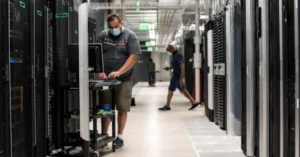The distinction between Bare Metal Cloud and a dedicated server is often misunderstood by users.
This is unsurprising considering how similar they are. Despite this, the Bare Metal Cloud (BMC) provides scaling and automation capabilities that traditional dedicated servers lack.
Key Differences
- Server provisioning is automated with Bare Metal Cloud, whereas dedicated servers require manual provisioning.
- API-driven server provisioning, infrastructure as code capabilities, and integrations with IaC tools like Terraform, Ansible, and Pulumi are all available through Bare Metal Cloud.
- As a result, Bare Metal Cloud servers boot up in under two minutes. Manually setting up a dedicated server, on the other hand, takes a long time and can take anywhere from a few days to several weeks, depending on the complexity of the configuration.
- It is much easier to boot up identical environments using BMC and IaC tools.
- You can pay per hour, monthly, or reserve resources in advance with Bare Metal Cloud’s flexible billing options. Dedicated servers, on the other hand, require monthly or yearly contracts.
- Despite the fact that they are both single-tenant environments, Bare Metal Cloud gives you easier access to the latest hardware. While you can upgrade existing dedicated servers, it’s much easier to spin up a BMC instance with the required configuration in under 120 seconds.
What is Bare Metal Cloud?
A bare-metal cloud server is a non-virtualized, single-tenant environment with cloud-like scaling capabilities. It makes full use of the server’s physical hardware as a single-tenant environment. Because all physical resources are dedicated to your use only, there is no “noisy neighbors” effect as in other cloud environments.
Bare Metal Cloud servers deliver maximum performance due to their processing capacity. They provide you with complete control over all physical elements. As a result, you can tailor the server to your specific workloads.
Support for automation-driven IT infrastructure is one of Bare Metal Cloud’s most important features. The service includes a user-friendly API and CLI that let you treat your infrastructure like code and integrate it with open-source automation tools.
Bare Metal Cloud vs Dedicated Servers
Between Bare Metal Cloud and dedicated servers, there are a few key distinctions.
- Support for APIs and Command Line Interfaces (CLI). API-driven provisioning is one of the main features that distinguish a BMC server from a dedicated server. Developers can automate server provisioning instead of manually spinning up instances.
- Infrastructure as a source of code support Treating infrastructure as code is possible with Bare Metal Cloud. Using IaC tools, users can automatically configure environments and set up the required systems and devices. Reusable scripts save time by constructing the necessary infrastructure. Furthermore, building infrastructure with reusable scripts is the simplest way to ensure environmental stability and consistency throughout the DevOps pipeline.
- The time it takes to deploy something. You can start a BMC instance in less than 120 seconds thanks to its integration with automation tools. Dedicated servers, on the other hand, can take anywhere from days to weeks to set up. When you need to scale up resources quickly, the ability to quickly spin up instances is critical. The process is not only slower but also more prone to errors without IaC.
- Model for billing. Bare Metal Cloud’s hourly/monthly or reservation billing model allows you to use resources as needed without committing to a long-term contract. As a result, you can scale your resources as needed or set aside resources for later use. Monthly and yearly payment plans are available for dedicated servers, which are better if you need hosting resources for a long time.
- You’ll have access to the most up-to-date server configurations. If you need servers with the most up-to-date technology, it’s simple to find a BMC server that meets your needs and rent it as needed. The latest hardware and storage solutions are installed on Bare Metal Cloud servers. Upgrades to dedicated servers’ resources are also possible, but the process is time-consuming and costly.
Bare Metal Cloud Use Cases
Websites for E-commerce
The e-commerce industry experiences fluctuating traffic throughout the year. During the holidays, the industry typically sees a significant increase in traffic. When a company needs more resources to handle a large workload, this is when they need to hire more people. Resource reservation and hourly billing are available in Bare Metal Cloud, making it ideal for anticipated workload bursts.
Processing of Large Amounts of Data
BMC is the right choice if you need to process large amounts of data on a regular or periodic basis. By reserving resources, you can scale your infrastructure and spin up additional servers for data processing only when needed. In this case, using BMC is the most convenient and cost-effective option because you can pay by the hour. You simply shut down the surplus Bare Metal Cloud server once the data has been processed.
Farms for Rendering
In order to calculate computer images, 3D animation studios must set up clusters of servers. Render farms are the name for these clusters. Designers can use a Bare Metal Cloud server instead of turning a workstation into a cluster for rendering images. Configuring the BMC as the master node is often the best option in such use cases due to its flexibility. It can quickly spin up rendering nodes to speed up the process when needed, without requiring long-term or expensive investment.
Development of an Application
BMC provides an excellent environment for DevOps teams to build, test, and deploy their applications during application development. Bare Metal Cloud’s main benefit is its cloud-native architecture, which allows developers to treat infrastructure like code. Developers can maintain the same application environment throughout the development pipeline thanks to reusable scripts. Because its testing environment mirrors production, this feature is critical for optimizing the CI/CD pipeline.





Leave a Reply
You must be logged in to post a comment.